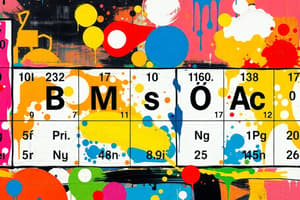Podcast
Questions and Answers
Which statement accurately describes the relationship between elements and compounds?
Which statement accurately describes the relationship between elements and compounds?
- Elements are combinations of different compounds, maintaining their individual properties.
- Elements and compounds are both types of mixtures with variable compositions.
- Compounds are formed when two or more elements are chemically bonded together. (correct)
- Elements are composed of compounds, which are simpler substances.
What distinguishes a mixture from a compound?
What distinguishes a mixture from a compound?
- Mixtures involve chemical bonding, while compounds are physically combined.
- Mixtures have a fixed composition, while compounds have variable compositions.
- Mixtures can only be homogeneous, while compounds can be either homogeneous or heterogeneous.
- Mixtures retain the individual properties of their components, while compounds form new substances with altered properties. (correct)
Isotopes of an element are determined by which factor?
Isotopes of an element are determined by which factor?
- Consistent number of neutrons.
- Same number of neutrons, different number of protons.
- Varying number of protons.
- Same number of protons, different number of neutrons. (correct)
Which property is generally associated with metals?
Which property is generally associated with metals?
How do metalloids differ from metals and nonmetals?
How do metalloids differ from metals and nonmetals?
What is the central focus of chemistry as a field of study?
What is the central focus of chemistry as a field of study?
Which statement correctly describes the arrangement of atoms in solid, liquid, and gaseous states?
Which statement correctly describes the arrangement of atoms in solid, liquid, and gaseous states?
What determines the atomic number of an atom?
What determines the atomic number of an atom?
Which subatomic particle contributes least to the atomic mass number?
Which subatomic particle contributes least to the atomic mass number?
What is the significance of a full outer electron shell in an atom?
What is the significance of a full outer electron shell in an atom?
How does an atom become an ion?
How does an atom become an ion?
What primarily holds ions together in a compound?
What primarily holds ions together in a compound?
Which of the following particles is positively charged and located in the nucleus of an atom?
Which of the following particles is positively charged and located in the nucleus of an atom?
Why are noble gases generally unreactive?
Why are noble gases generally unreactive?
Which statement best describes the movement of electrons in an atom?
Which statement best describes the movement of electrons in an atom?
How does the number of electrons typically compare to the number of protons in a neutral atom?
How does the number of electrons typically compare to the number of protons in a neutral atom?
What happens when an atom gains electrons?
What happens when an atom gains electrons?
Which of the following is an example of a molecule?
Which of the following is an example of a molecule?
What role do neutrons play in the nucleus of an atom?
What role do neutrons play in the nucleus of an atom?
Which property is least associated with nonmetals?
Which property is least associated with nonmetals?
Flashcards
Elements
Elements
Substances that cannot be broken down into other substances by chemical means.
Compounds
Compounds
Substances formed when two or more different elements are chemically bonded together.
Molecules
Molecules
Groups of two or more atoms held together by chemical bonds.
Mixtures
Mixtures
Signup and view all the flashcards
Isotopes
Isotopes
Signup and view all the flashcards
Metals
Metals
Signup and view all the flashcards
Nonmetals
Nonmetals
Signup and view all the flashcards
Metalloids
Metalloids
Signup and view all the flashcards
Chemistry
Chemistry
Signup and view all the flashcards
Matter
Matter
Signup and view all the flashcards
Atoms
Atoms
Signup and view all the flashcards
Protons
Protons
Signup and view all the flashcards
Neutrons
Neutrons
Signup and view all the flashcards
Electrons
Electrons
Signup and view all the flashcards
Noble Gases
Noble Gases
Signup and view all the flashcards
Ion
Ion
Signup and view all the flashcards
Study Notes
- Elements are pure substances that cannot be broken down further.
- Compounds consist of two or more elements bonded together.
- Molecules are small groups of atoms joined by atomic bonds.
- Mixtures are combinations of two or more substances.
- Isotopes are atoms with the same number of protons but different numbers of neutrons, leading to different atomic masses.
Metals
- High luster.
- Good conductors of electricity and heat.
- Ductile (can be drawn into wires).
- Malleable (can be hammered into thin sheets).
- Most are solid at room temperature.
Nonmetals
- Low luster.
- Poor conductors.
- Brittle.
- Can exist as various states of matter at room temperature.
Metalloids
- Have properties intermediate between metals and nonmetals.
- Located on the stair-step line separating metals and nonmetals on the periodic table.
Chemistry
- The study of the composition of substances.
- Matter is anything that has mass and occupies space.
- Atoms are the fundamental building blocks of matter.
- Atoms in solids are more tightly packed than in liquids.
- The atom's nucleus contains protons and neutrons.
- Electrons orbit the nucleus in a cloud.
- The negative charge of an electron equals the positive charge of a proton.
- Atoms have no overall charge because they contain an equal number of protons and electrons.
Protons
- Positively charged particles.
- Located in the nucleus.
- The number of protons defines the atomic number.
- Contributes to the atomic mass number.
- The number of protons equals the number of electrons in a neutral atom.
Neutrons
- Neutral (no charge) particles.
- Located in the nucleus.
- Contributes to the atomic mass.
Electrons
- Negatively charged particles.
- Move rapidly around the nucleus (electron cloud).
- The mass of an electron is negligible compared to protons and neutrons; therefore, it does not determine the atomic mass number.
Noble Gases
- Atoms of noble gases have full outer electron shells and are stable.
- Noble gases are unreactive and do not usually form bonds.
- Other elements have incomplete outer electron shells and are unstable.
- Atoms become more stable by achieving an electron arrangement like that of noble gases (full outer shell).
- In a stable atom, the number of electrons equals the number of protons.
Ions
- An ion is an atom with a different number of electrons than protons.
- An ion is formed when an atom gains or loses one or more electrons.
- Compounds are formed when two or more ions are held together by electrical attraction (e.g., Na+).
Studying That Suits You
Use AI to generate personalized quizzes and flashcards to suit your learning preferences.





